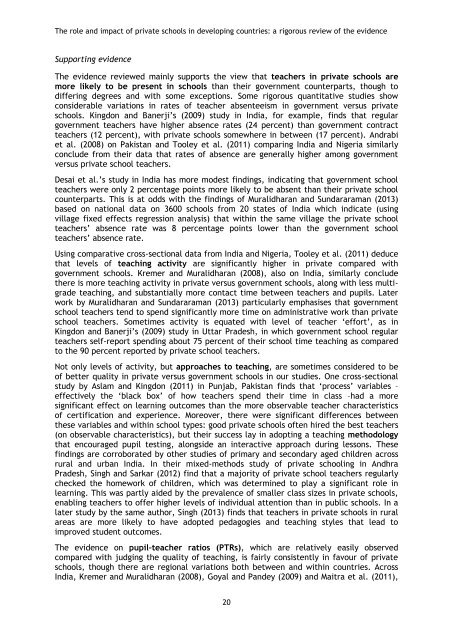private-schools-full-report
private-schools-full-report
private-schools-full-report
You also want an ePaper? Increase the reach of your titles
YUMPU automatically turns print PDFs into web optimized ePapers that Google loves.
The role and impact of <strong>private</strong> <strong>schools</strong> in developing countries: a rigorous review of the evidence<br />
Supporting evidence<br />
The evidence reviewed mainly supports the view that teachers in <strong>private</strong> <strong>schools</strong> are<br />
more likely to be present in <strong>schools</strong> than their government counterparts, though to<br />
differing degrees and with some exceptions. Some rigorous quantitative studies show<br />
considerable variations in rates of teacher absenteeism in government versus <strong>private</strong><br />
<strong>schools</strong>. Kingdon and Banerji’s (2009) study in India, for example, finds that regular<br />
government teachers have higher absence rates (24 percent) than government contract<br />
teachers (12 percent), with <strong>private</strong> <strong>schools</strong> somewhere in between (17 percent). Andrabi<br />
et al. (2008) on Pakistan and Tooley et al. (2011) comparing India and Nigeria similarly<br />
conclude from their data that rates of absence are generally higher among government<br />
versus <strong>private</strong> school teachers.<br />
Desai et al.’s study in India has more modest findings, indicating that government school<br />
teachers were only 2 percentage points more likely to be absent than their <strong>private</strong> school<br />
counterparts. This is at odds with the findings of Muralidharan and Sundararaman (2013)<br />
based on national data on 3600 <strong>schools</strong> from 20 states of India which indicate (using<br />
village fixed effects regression analysis) that within the same village the <strong>private</strong> school<br />
teachers’ absence rate was 8 percentage points lower than the government school<br />
teachers’ absence rate.<br />
Using comparative cross-sectional data from India and Nigeria, Tooley et al. (2011) deduce<br />
that levels of teaching activity are significantly higher in <strong>private</strong> compared with<br />
government <strong>schools</strong>. Kremer and Muralidharan (2008), also on India, similarly conclude<br />
there is more teaching activity in <strong>private</strong> versus government <strong>schools</strong>, along with less multigrade<br />
teaching, and substantially more contact time between teachers and pupils. Later<br />
work by Muralidharan and Sundararaman (2013) particularly emphasises that government<br />
school teachers tend to spend significantly more time on administrative work than <strong>private</strong><br />
school teachers. Sometimes activity is equated with level of teacher ‘effort’, as in<br />
Kingdon and Banerji’s (2009) study in Uttar Pradesh, in which government school regular<br />
teachers self-<strong>report</strong> spending about 75 percent of their school time teaching as compared<br />
to the 90 percent <strong>report</strong>ed by <strong>private</strong> school teachers.<br />
Not only levels of activity, but approaches to teaching, are sometimes considered to be<br />
of better quality in <strong>private</strong> versus government <strong>schools</strong> in our studies. One cross-sectional<br />
study by Aslam and Kingdon (2011) in Punjab, Pakistan finds that ‘process’ variables –<br />
effectively the ‘black box’ of how teachers spend their time in class –had a more<br />
significant effect on learning outcomes than the more observable teacher characteristics<br />
of certification and experience. Moreover, there were significant differences between<br />
these variables and within school types: good <strong>private</strong> <strong>schools</strong> often hired the best teachers<br />
(on observable characteristics), but their success lay in adopting a teaching methodology<br />
that encouraged pupil testing, alongside an interactive approach during lessons. These<br />
findings are corroborated by other studies of primary and secondary aged children across<br />
rural and urban India. In their mixed-methods study of <strong>private</strong> schooling in Andhra<br />
Pradesh, Singh and Sarkar (2012) find that a majority of <strong>private</strong> school teachers regularly<br />
checked the homework of children, which was determined to play a significant role in<br />
learning. This was partly aided by the prevalence of smaller class sizes in <strong>private</strong> <strong>schools</strong>,<br />
enabling teachers to offer higher levels of individual attention than in public <strong>schools</strong>. In a<br />
later study by the same author, Singh (2013) finds that teachers in <strong>private</strong> <strong>schools</strong> in rural<br />
areas are more likely to have adopted pedagogies and teaching styles that lead to<br />
improved student outcomes.<br />
The evidence on pupil–teacher ratios (PTRs), which are relatively easily observed<br />
compared with judging the quality of teaching, is fairly consistently in favour of <strong>private</strong><br />
<strong>schools</strong>, though there are regional variations both between and within countries. Across<br />
India, Kremer and Muralidharan (2008), Goyal and Pandey (2009) and Maitra et al. (2011),<br />
20


